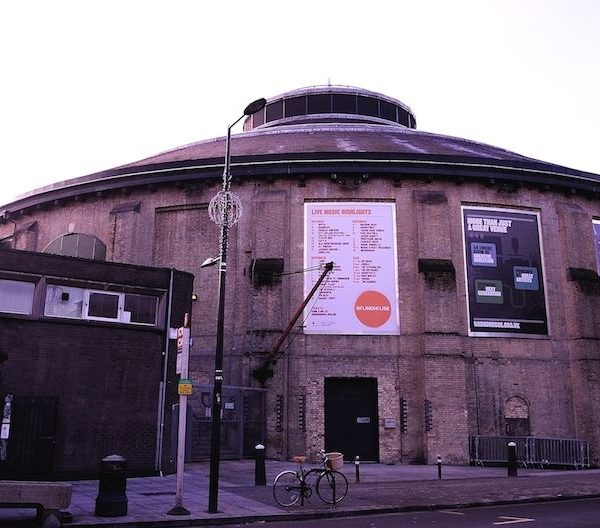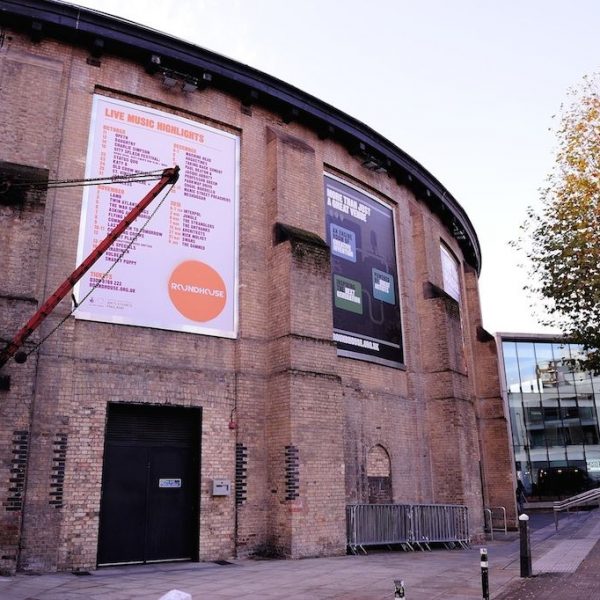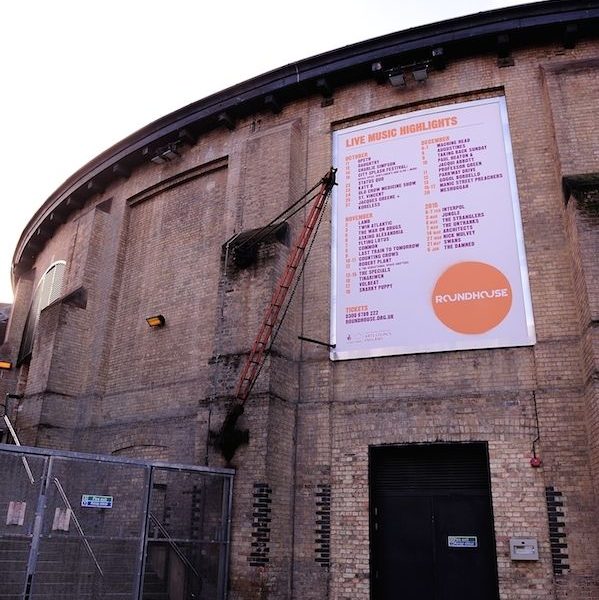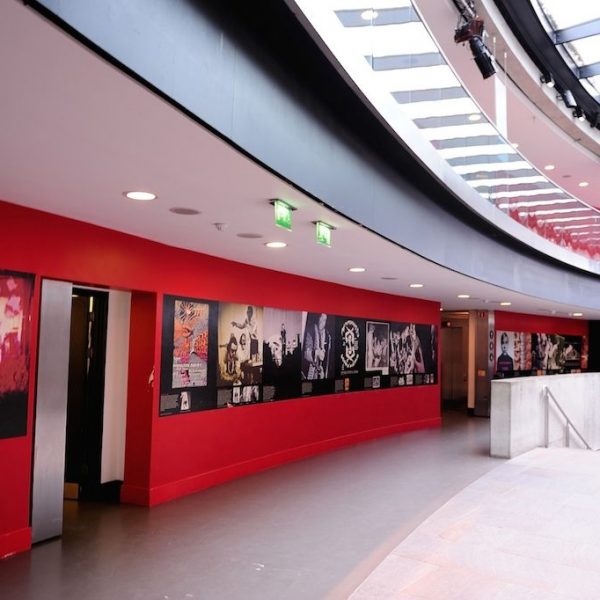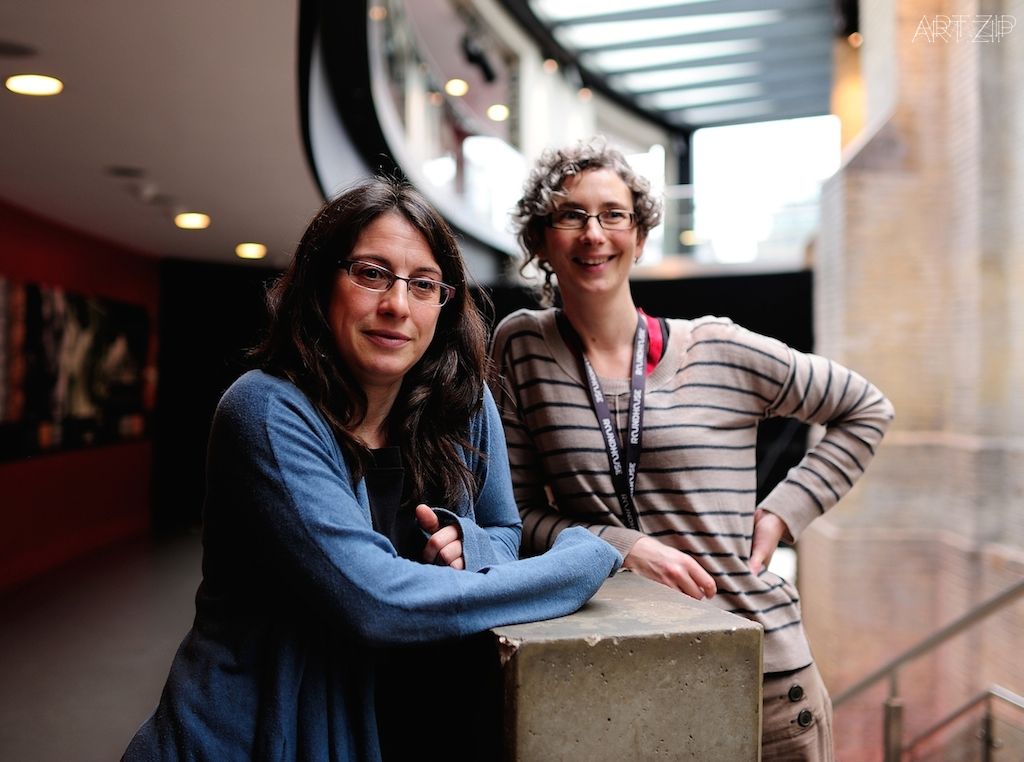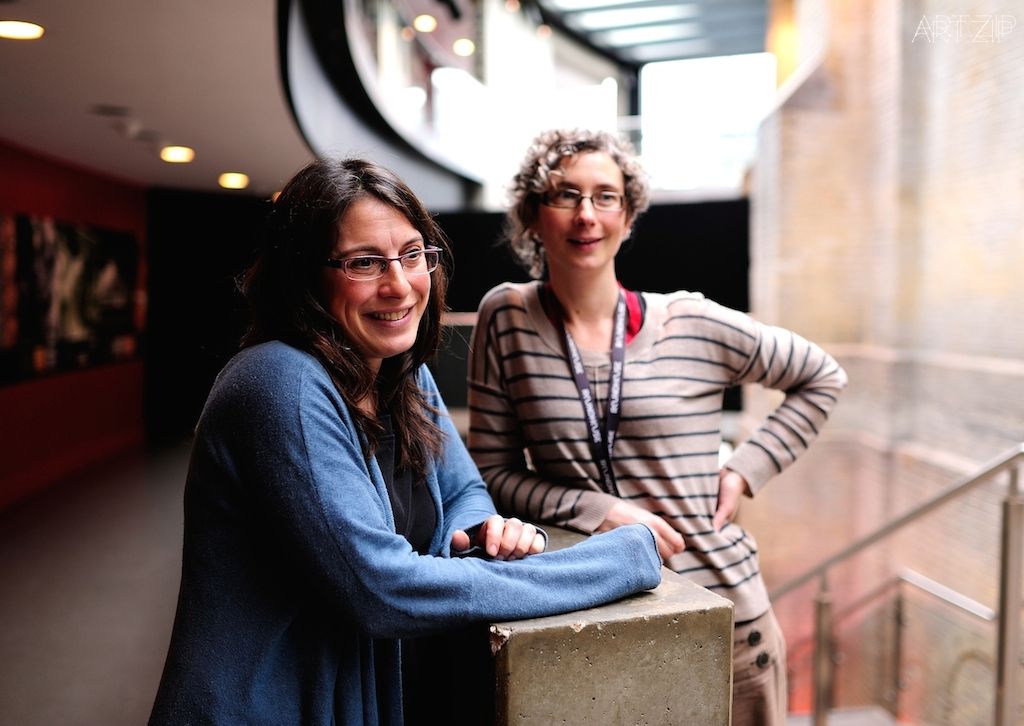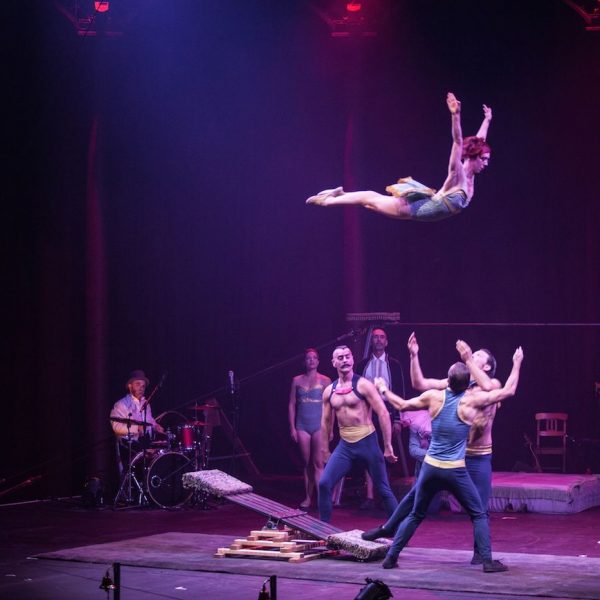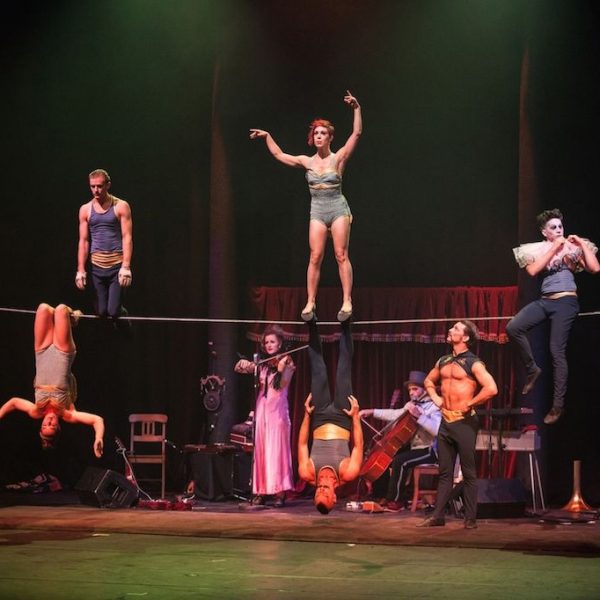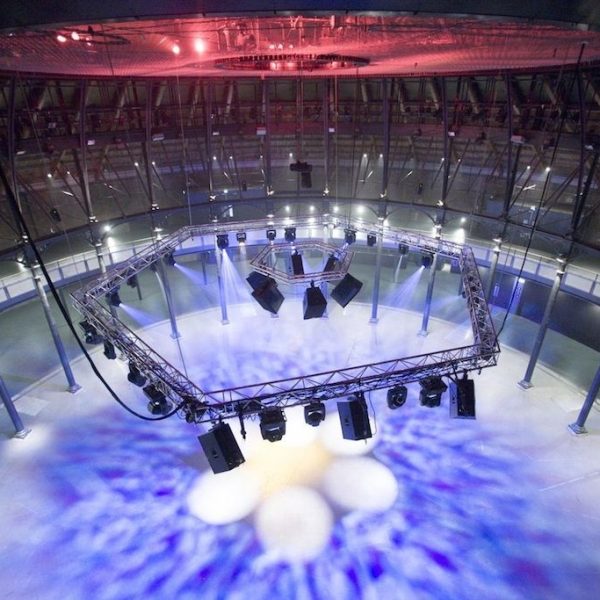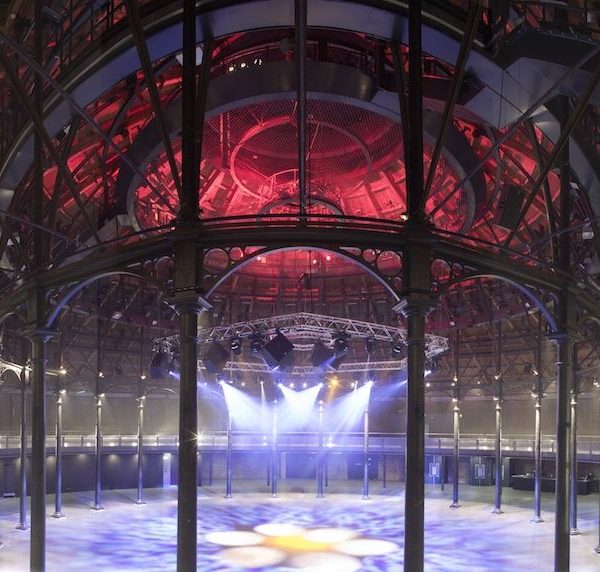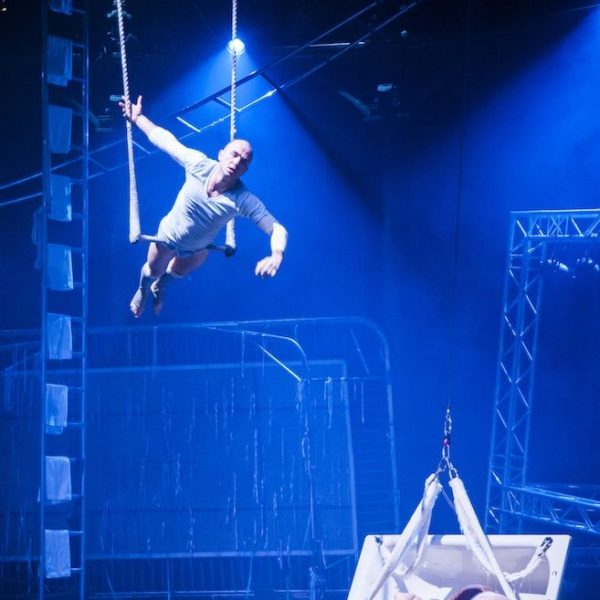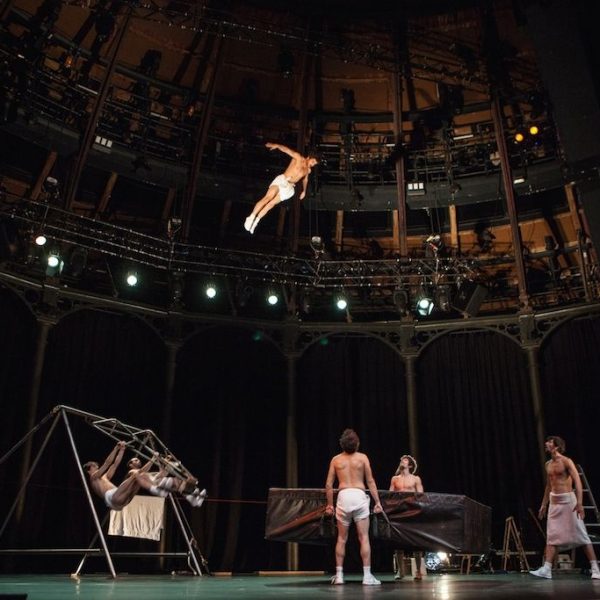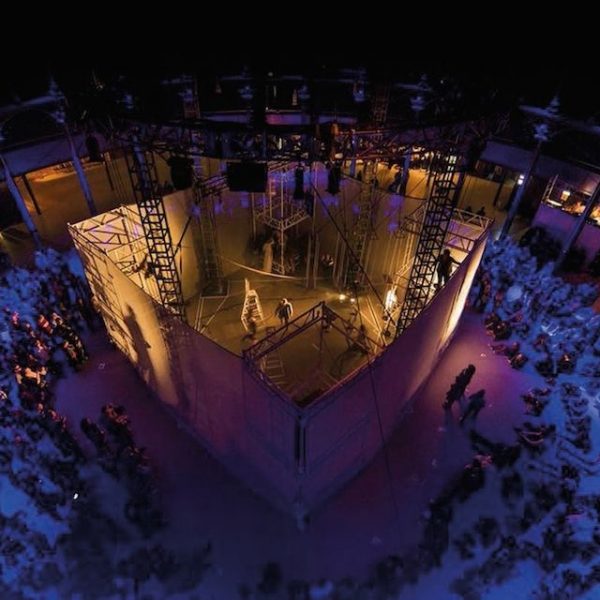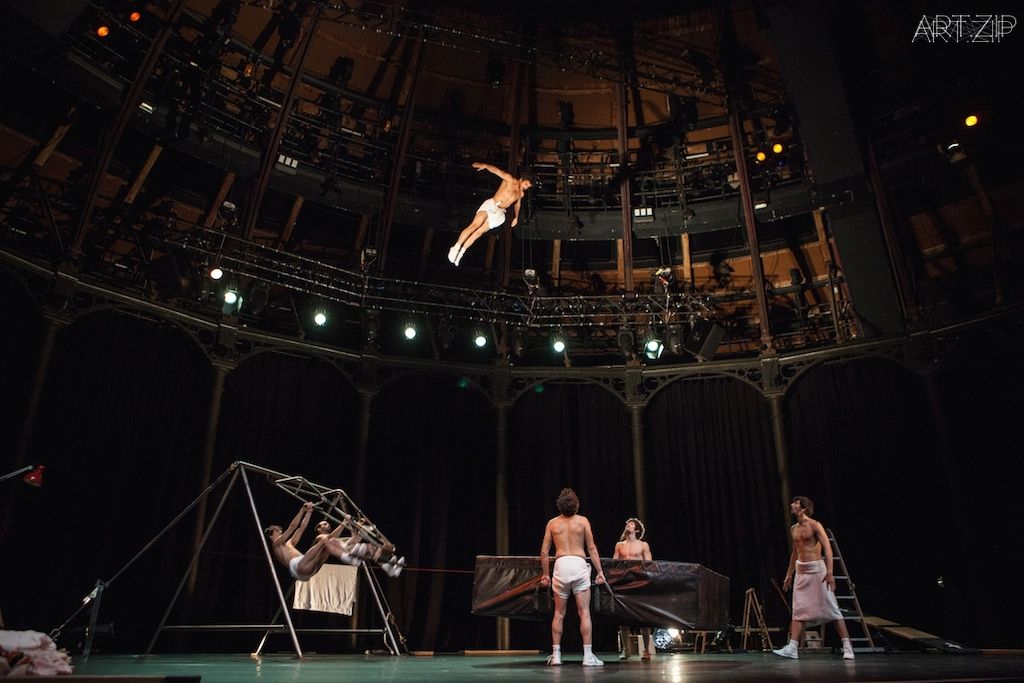
Interviewed by: Joanna Dong 採訪:董一燃
Edited by: Struan Robinson& Sarah Pettitt 編輯整理:Struan Robinson& Sarah Pettitt
Translated by: Chen Ting 翻譯:陳婷
Originally built in 1847 as a railway turntable engine shed, Chalkfarm’s Roundhouse is now better known for serving London’s culture and arts than its railways. Its conversion from a disused locomotive house to a permanent cultural centre began 15 years after its completion, when progressions within the railway industry meant that engines would no longer fit within its walls. No longer fit for purpose, the venue passed hands until 1960 when English dramatist Arnold Wesker founded his own theatre, known as Centre 42, on the premises. In 1964, having gathered the sufficient funds (£5.3 million in today’s money), Wesker converted the building into an innovative performing arts space with its own theatre, cinema, art gallery, library, youth club, restaurant and dance hall.
位於倫敦喬克法姆的圓屋劇場落成於1847年,當時還是一間火車站的扇形車庫,後來成為當地的文化藝術場所。建成15年後,由於鐵路運輸的發展,當時的車庫已無法繼續使用,才從廢棄的車庫徹底轉變為文化中心。直到1960年,英國劇作家阿諾德·威斯克(Arnold Wesker)接手這個已停用的場館,建立了名為42中心的劇場。1964年,威斯克籌集到足夠資金(相當於今天的530萬英鎊),把劇場改造成集戲劇、影院、畫廊、圖書館、青年俱樂部、餐廳和舞廳為一體的創意表演藝術中心。
 Since then, the Roundhouse has made a name for itself for presenting boundary-breaking theatre, from critically acclaimed director Peter Brook’s 1968 experimental work Themes on the Tempest to Ken Campbell’s 24 hour long play The Warp which tells the story of central character Phil Masters – according to the Guinness Book of World Records, the longest play ever performed. Previous Roundhouse productions have even caused controversy and made news items, most notably the 1970 performances of Kenneth Tynan’s revue Oh! Calcutta, in which all performers appear naked on stage and perform musical sketches (one of which was written by Beatles front man John Lennon) about lewd and sexual subjects. At the time, the production caused something of a scandal with the some members of the British press calling it “pornography”, however, the show proved to be both an artistic and commercial success and went on to transfer to London’s theatrical hub: The West End where it ran for four years.
Since then, the Roundhouse has made a name for itself for presenting boundary-breaking theatre, from critically acclaimed director Peter Brook’s 1968 experimental work Themes on the Tempest to Ken Campbell’s 24 hour long play The Warp which tells the story of central character Phil Masters – according to the Guinness Book of World Records, the longest play ever performed. Previous Roundhouse productions have even caused controversy and made news items, most notably the 1970 performances of Kenneth Tynan’s revue Oh! Calcutta, in which all performers appear naked on stage and perform musical sketches (one of which was written by Beatles front man John Lennon) about lewd and sexual subjects. At the time, the production caused something of a scandal with the some members of the British press calling it “pornography”, however, the show proved to be both an artistic and commercial success and went on to transfer to London’s theatrical hub: The West End where it ran for four years.
圓屋劇場從此因其打破了藝術的界限而一舉成名。上演的劇碼包括備受業界讚賞的戲劇導演彼得·布魯克(Peter Brook)1968年的前衛劇作《暴風雨(Themes on the Tempest)》,以及吉尼斯世界紀錄中最長的戲劇—肯·坎貝爾(Ken Campbell)長達24小時的作品《茶經(The Warp)》, 故事圍繞主人公費爾·馬斯特斯(Phil Masters)展開。圓屋劇場曾因其劇碼引起爭議而成為新聞話題,最出名的是1970年演出的肯尼士·泰南(Kenneth Tynan)代表作《加爾哥答風情畫(Oh! Calcutta!)》。劇中舞臺上演員全部赤身裸體,加上淫穢色情的音樂素描(其中一首為甲殼蟲樂隊主唱約翰·列儂創作),以至於被部分英國媒體稱為色情作品,引起軒然大波。然而,這部作品卻因其藝術價值和商業成功而被搬上了西區劇院,在倫敦戲劇最核心的地段表演了整整四年。
The Roundhouse has moved between the controversial and the classical, experimental theatre and straight-laced. It has enjoyed a partnership with theRoyal Shakespeare Company (RSC) since the 1990s, having presented three seasons of the renowned company’s work within the ‘Roundyard’ – a purpose built replica of the RSC’s Courtyard Theatre in Stratford-Upon-Avon. Former artistic director, Michael Boyd, transferred his ‘Histories Cycle’ to the venue in 2008, where it proved to be a hit among audiences and critics alike – the Observer calling it: “once-in-a-lifetime theatrical experience”.
圓屋劇場的風格在經典、前衛、備受爭議和古板拘謹中反復。自20世紀90年代起,圓屋劇場與皇家莎士比亞劇團(Royal Shakespeare Company,簡稱RSC)建立了合作關係,並複製了RSC在斯特拉特福德的新庭院劇院,建造了自己的“圓屋庭院”劇院,演出了三季RSC的劇作。2008年,劇團前藝術總監邁克爾·博伊德(Michael Boyd)將作品《歷史的輪迴(Histories Cycle)》搬上了圓屋劇場的舞臺,受到觀眾和評論界一致好評。英國《觀察家》報稱之為“千載難逢的戲劇觀賞經歷”。
Its distinctive circular shape, pointed roof, and yellow brick, have made the Roundhouse one of London’s most instantly recognizable theatrical venues. A recurring theme is to use the presenting house’s unique shape to reflect or enhance the 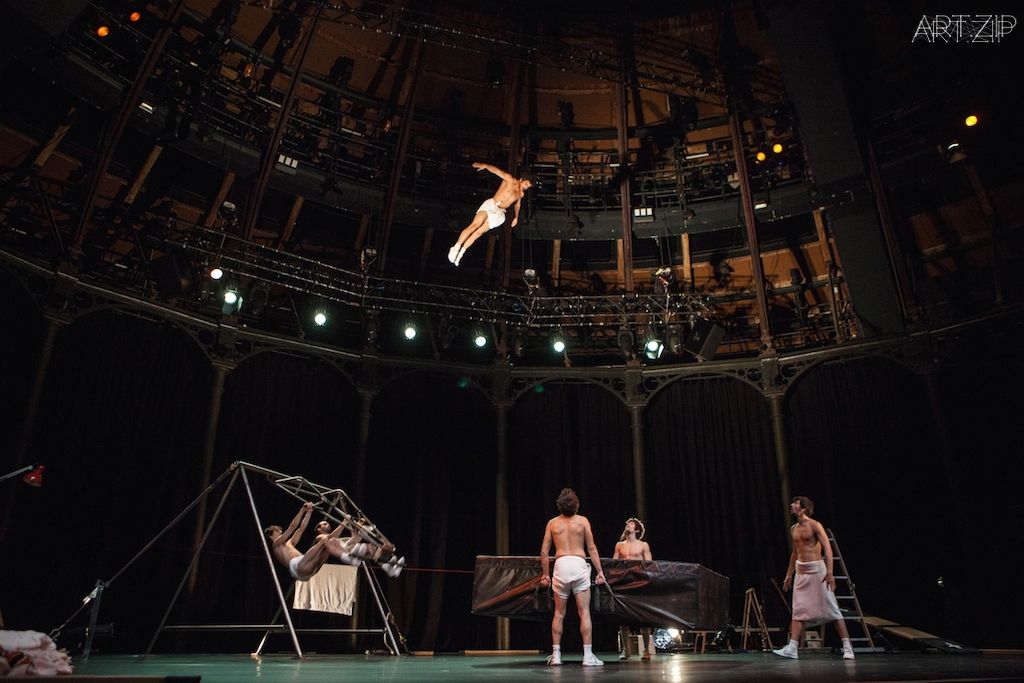 work it shows. In 2012, the Roundhouse joined forces with the 360-degree network of round venues across Europe to commission a major new work by world-renowned theatre-maker Robert Lepage, specifically designed to be performed in the round. Presented for the first time in the UK in early 2013, Playing Cards 1: SPADES was the first in a planned series of four plays, each shaped around one suit in a deck of cards. The first part, SPADES, explored the theme of war and was set in the desert city of Las Vegas at the onset of the US invasion of Iraq in 2003.
work it shows. In 2012, the Roundhouse joined forces with the 360-degree network of round venues across Europe to commission a major new work by world-renowned theatre-maker Robert Lepage, specifically designed to be performed in the round. Presented for the first time in the UK in early 2013, Playing Cards 1: SPADES was the first in a planned series of four plays, each shaped around one suit in a deck of cards. The first part, SPADES, explored the theme of war and was set in the desert city of Las Vegas at the onset of the US invasion of Iraq in 2003.
圓屋劇場外觀獨特,呈圓形尖頂,由黃磚砌成,是倫敦最易辨認的劇場之一。劇場也不斷利用其建築特色來襯托演出內容。例如2012年,該劇場與全歐洲其他圓形劇場合作,委託世界著名戲劇導演羅伯特· 勒帕吉(Robert Lepage)為圓形劇場量身打造了360度全景新劇。《撲克牌第一部曲:黑桃(Playing Cards 1: SPADES)》於2013年初首次亮相英國。《撲克牌》共分四部曲,每部圍繞撲克牌的一種花色。首部曲《黑桃》以2003年美國入侵伊拉克的戰爭背景為主題,場景設定在沙漠中的城市拉斯維加斯。
Work isn’t just displayed within the former railway building but actually below it as well. The same year the presenting house showed The Dark Side of Love, a co-production with LIFT in association with the Royal Shakespeare Company, staged in the intimate Dorfman Hub deep beneath the Roundhouse. Featuring scenes from Hamlet, Othello and Romeo and Juliet and performed in promenade by a cast of London and Brazilian teenagers, The Dark Side of Love was an intense and atmospheric experience where love represented not an ascent into heavenly bliss, but a descent into hellish despair.
圓屋劇場的演出並不只是在劇場內部,有時甚至會在劇場地下。圓屋劇場聯合皇家莎士比亞劇團,與倫敦國際戲劇節共同製作的《愛的陰暗面(The Dark Side of Love)》就是在劇場地下的多夫曼中心(Dorfman Hub)上演的。演員都是來自英國和巴西的青少年,以行進式表演呈現了《哈姆雷特(Hamlet)》、《奧賽羅(Othello)》及《羅密歐與茱麗葉(Romeo and Juliet)》中的劇情,強烈而富有感染力,把愛情刻畫成陷入地獄般的絕望,而非升上天堂般的喜悅。
The Roundhouse’s success is multi-faceted and has not just been confined to one media; it has attracted some of the biggest names in music with performances by Elton John, the Rolling Stones, Jimi Hendrix, and Led Zepplin throughout the punk rock era of the 1970’s. It has been the setting for music videos for the likes of the Manic Street Preachers, Stereophonics, and the Lost Prophets and has played host to the iTunes Festival and BBC Electric Proms; in 2010 it even created its own record label: Roundhouse Records. The venues on-site Roundhouse Radio launched in 2008, a community radio station developing the careers of young radio presenters, producers and DJs and has streamed the Roundhouse’s artistic program to audiences around the globe, producing over 130 live broadcast since its inception.
圓屋劇場的成功因素是多方面的,且不局限在一個領域。在朋克搖滾盛行的20世紀70年代,圓屋劇場吸引了包括艾爾頓·約翰(Elton John)、滾石樂隊(Rolling Stones)、吉米·亨德里克斯(Jimi Hendrix)、齊柏林飛艇(Led Zepplin)在內的音樂界巨星前來表演,並曾被狂躁街道傳教者(Manic Street Preachers)、立體音響樂隊(Stereophonics)、洛斯帕飛樂團(Lost Prophets)等樂隊選為MV拍攝地點,也舉辦過iTunes音樂節和BBC電子音樂節,甚至在2010年成立了自己的唱片公司:圓屋唱片(Roundhouse Records)。此外,圓屋劇場還於2008年在場內成立了社區電臺,名為圓屋電臺(Roundhouse Radio),為年輕的電臺播音、製作和DJ提供職業發展機會,將自己的藝術節目面向全球聽眾廣播,自成立起已播出130多期直播欄目。
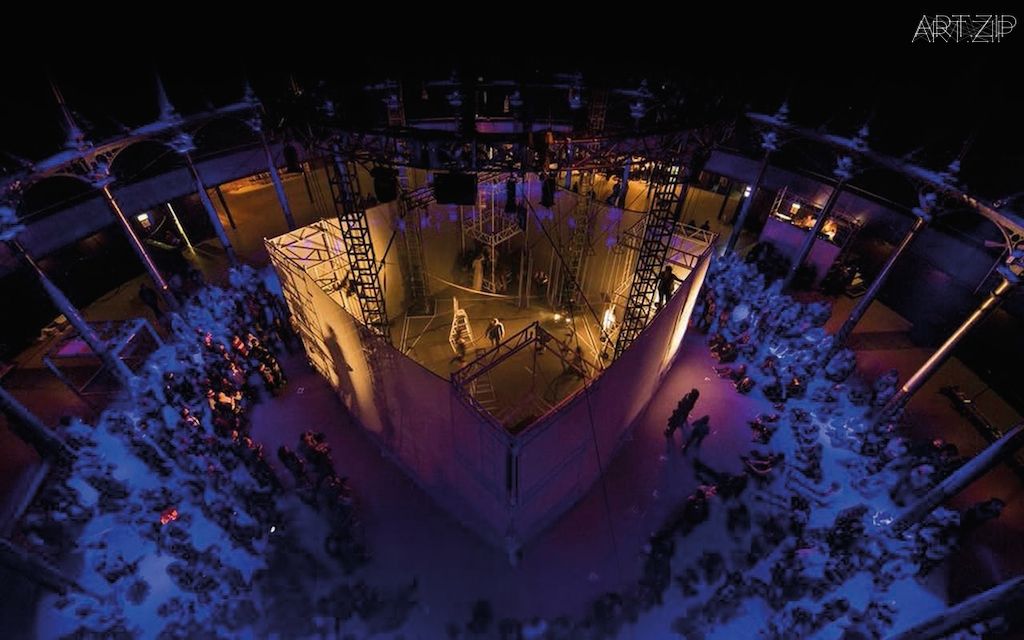 Amongst these theatrical, musical, and multi-media landmarks and achievements, what stands out most about the Roundhouse is its ability to adapt and move with the times both in terms of the work it shows and the projects it puts its name to, truly fulfilling Wesker’s wish of a venue that acts as a “cultural hub, which by its approach and work, will destroy the mystique and snobbery associated with the arts”.
Amongst these theatrical, musical, and multi-media landmarks and achievements, what stands out most about the Roundhouse is its ability to adapt and move with the times both in terms of the work it shows and the projects it puts its name to, truly fulfilling Wesker’s wish of a venue that acts as a “cultural hub, which by its approach and work, will destroy the mystique and snobbery associated with the arts”.
The Roundhouse could be the most famous venue in London for staging circus, from innovating contemporary circus performance to a variety of circus festivals, so we interviewed the circus producers, Pamela Vision and Hannah Bruce, to talk more about the circus programmes at the Roundhouse.
儘管在戲劇、音樂、多媒體等領域取得了一個個里程碑式的成就,圓屋劇場最傑出的一點仍是不斷與時代共同進步的能力,呈現的作品和參與的項目真正實現了當年威斯克的願景,那就是成為一個“文化中心,其作品和操作模式將結束藝術神秘和自命不凡的一面”。
圓屋劇場對當代馬戲表演的創新以及舉辦各類馬戲節,都使其稱得上是倫敦最著名的馬戲劇場。因此,本期我們採訪了兩位製作人帕梅拉·維什(Pamela Vision)和布魯斯·漢娜(Hannah Bruce),來詳細談一下圓屋劇場的馬戲節目。
INTERVIEW
ART.ZIP: How did the Roundhouse become a famous circus venue – perhaps the unique shape of the building is a clue? What is the history of the building?
PV&HB: You’re right – the building is almost like a circus tent – however, originally the building was a place where trains turned around. It was at the end of a train line and was the shell of an old railway building which was refurbished in 2006 – hence it has its unique shape.
The great thing for circus is that it has a lot of height which most venues don’t have and it also has the round shape. We don’t always present circus in the round, but we have the option to do that if we want to, which makes it really flexible. I guess just the scale of the building works really well for circus – it’s just such a huge space. Circus has a lot of bodies flying very high and you can really see that.
ART.ZIP: 首先我想問問,圓屋劇場是怎樣成為如今這個鼎鼎大名的馬戲團表演場所的? 是不是和它獨特的建築外形有關呢?那這棟建築有著怎樣的歷史呢?
PV&HB: 沒錯,這棟建築本身就像是一個馬戲團,但實際上這棟樓本來是給火車掉頭轉向用的。它原本在一條火車軌道的最末端,在2006年時重新翻新過,於是便有了現在這一獨特的外形。
馬戲團的一個優勢,正在於它有著其他場所沒有的挑高高度,還有那獨特的圓形構造。盡管我們不常上演馬戲表演,但我們有條件作此類演出,它具有相當的靈活性。我覺得整棟建築的規模的確很適合馬戲表演 ──這可是多大的一個空間啊。馬戲表演中,很多表演者多需要在高空飛來飛去,而在這個空間裡我們都能完整的看到。
ART.ZIP: So the venue inside is very flexible – and it can be adapted to the different requirements of the changing shows?
PV&HB: Exactly. For example, we can make the seating different depending on the show – so we have a great deal of flexibility to work with different companies and it allows us to have a wide range of different performances at the Roundhouse.
ART.ZIP: 所以場地本身其實是很具靈活性的?它能夠適應不同表演的不同需求?
PV&HB: 正是如此,我們可以根據不同表演需求來調整座位高度 ──我們在和不同的劇團合作時具有相當大的靈活性,而這也使我們可以給觀眾帶來諸多不同種類的表演。
ART.ZIP: So, initially, when the building was adapted into a theatre venue, it was not tailor-made for circus?
PV&HB: No – well, that’s a good question – I think the idea was always there that circus would be a strong part of the programme. When it was first opened there was already a commitment to circus and so I guess the kind of design for the refurbishment of the building had that included. It has never been exclusively for circus, so a large part of it is about being a flexible space. There is a lot of music, there is theatre, there are also a lot of commercial events and that kind of thing, so we have a big range of different activities.
ART.ZIP: 所以一開始,這棟建築實際上被改造成了一個戲劇表演場地,而不是為馬戲表演所量身訂造的,對嗎?
PV&HB: 不是的,這是個很好的問題,在我看來,馬戲表演一直是我們所重視的一部分。當圓屋劇場剛開業時,我們對馬戲表演就寄予了很大的重視。所以我覺得對建築的設計也把這部分的規劃包含了進去。但與此同時,圓屋劇場也從不僅僅是為了馬戲表演,更多的時候,它是一個具有相當靈活性的場地。其中就有音樂表演,戲劇表演,還有很多商業活動等等,我們的活動有著一個很大的跨度。
ART.ZIP: We are curious about the kind of audience circus attracts. Can you tell us a bit about the type of people who come to see circus? For example, traditionally when people think about circus they might think about going to see a performing tiger or something like that – what sort of circus do you show at the Roundhouse. Do you always programme contemporary circus? And what kind of people does it attract?
PV&HB: We do programme contemporary circus, not really traditional, although sometimes there are traditional influences – but never tigers or animals! What we are trying really hard to do, because we are the only circus festival in London, is develop the art form here in England. In Europe the art form is very, very important within the culture, like in France for example but in England it is still quite new. People don’t know quite what to make of it – so we are always trying to push that envelope further and further and make it more interesting and collaborate between dance and theatre and find new ways to interest audiences. Our audiences are very wide – we are well known as a music venue and well known as a young people’s venue so we get a huge young take up and we offer a lot of really good cheap price tickets for people under 25, so we get a huge amount of those people discovering new forms of theatre.
And also the way we programme the circus festival is constantly trying to think about attracting new audiences and finding new ways of interacting with audiences. So a major part of our job is to be constantly thinking about how we reach people. So, for example, next year – not as part of CircusFest because CircusFest is only every other year and the next CircusFest is 2016 but next year in 2015 at the same time as CircusFest we have a company called Circolumbia coming. They have a really strong connection with a very young, teenage audience. They work a lot with hip hop music and Columbian reggaeton music and so, for us, that is a perfect link because it ties in with the programme of the music in the building but it also brings contemporary circus. It brings a kind of South American style of circus which has a lot of big group acrobatics which aren’t often seen in the UK. All of these things link in with thinking about the audience, even while we are thinking about the style of circus and the programme. Our audience is not a static thing. It is constantly growing and it’s constantly changing and we are constantly trying to reach new people.
ART.ZIP: 我們對馬戲團會吸引怎樣的觀眾感到好奇,你能跟我們聊聊有哪些觀眾會來看馬戲團表演嗎?許多人在想到馬戲時,都會聯想到老虎或是其他動物表演,在圓屋劇場上演的是怎樣的馬戲呢?你們是否經常策劃當代馬戲表演?而它又會吸引怎樣的觀眾呢?
PV&HB: 我們策劃的多為當代馬戲,而不是傳統意義上的馬戲表演,盡管有些時候會有傳統因素的影響,但我們從來沒有老虎或其它動物在這裡演出過!我們主辦倫敦唯一一個馬戲表演節,我們一直在致力做的,是在英格蘭地區培養發展出一種藝術形式。而這種藝術形式在歐洲是非常重要的,比如在法國,但在英格蘭這還只能算得上一個新興事物。觀眾不知道該如何去欣賞,所以我們總是試圖尋求挑戰,將表演策劃的更有意思,並且和舞蹈、戲劇進行結合,不斷尋求新的模式引發觀眾的興趣。我們有著各種各樣的觀眾,正因為我們是以為音樂和年輕人服務的場地而聞名,所以我們的觀眾中有大量的年輕人,與此同時,我們也給25歲以下的年青人很大的優惠,所以許多年輕觀眾都在不斷欣賞和嘗試新的戲劇表演類型。
我們策劃馬戲表演節的方式,也是不斷地在尋求吸引新觀眾和探索與觀眾互動的新方式。所以我們的工作很大一部分是在思考如何接觸到觀眾。例如,明年我們會邀請到一個名為“哥倫比亞(Circolombia)”的劇團。他們和青少年觀眾互動相當緊密。他們使用不少嘻哈和哥倫比亞雷擊盾音樂等表演元素,在我們看來,他們正是絕佳的合作夥伴,因為那和我們的音樂項目有所相關,與此同時又引入了當代馬戲。他們帶來了一種拉丁美洲式的馬戲表演,其中有多人和集體式的體操表演,這在英國是比較少見的。而所有的這些都和我們對觀眾的考量息息相關,而與此同時,當然也有對馬戲表演風格和節目安排上的規劃。我們的觀眾不是一成不變的,觀眾群永遠在不斷擴張,不斷變化,而我們也在不斷嘗試吸引新的觀眾。
ART.ZIP: So talking about programming the shows in the building – as we see it there are not a huge amount of circus acts in the UK – how do you plan the acts for such a long period? What are your resources?
PV&HB: Well because we are an international festival what we balance is a kind of ‘best of’ what is happening internationally. We bring in at least two shows that are international, really large scale, really new and interesting that are changing the form of circus and that we just don’t see here in England. Then we balance that with developing UK artists, so we work all the time developing UK artists . We offer them space here and time and development, support to develop shows – sometimes over two years – which we can then bring to the festival. We work really closely with partners around London, so there are a few places which really develop circus – Jacksons Lane in Highgate, The Albany in Deptford, Stratford Circus, Arts Depot and Shoreditch Town Hall. They also help because they have smaller spaces which makes it easier for artists to start in. Oh, and of course the National Centre for Circus.
Yes, we have always had a relationship with them but recently we have established a really key partnership with the National Centre for Circus Arts, which used to be called the Circus Space. So what we are doing with them is developing, a more formal relationship with them because obviously they have a lot of graduates coming through their programme and so we try and work with them in helping to evolve and develop their work and to show work here. And they also have a creation space – so they help us with artists we are working with – because we have two spaces, we have a really big space and a really tiny space which has no height, so they work with us to give our artists space to help create work which they can then bring into our big space.
So I guess the key thing, to return to programming, is for us to think about the wider context of circus in the UK. So partly it is to show case international work and partly it is to develop the grassroots circus scene in the UK. But, I guess, the critical thing is we can’t work in isolation. It is really important to us to have these partnerships.
ART.ZIP: 說起圓屋劇場的節目安排,正如我們所說,英國沒有很多馬戲表演,那你們是如何策劃活動的呢?
PV&HB: 因為我們組織的是一個國際表演藝術節,所以我們會在引入全球範圍內最出色的的表演和培養英國本土表演之中做一個平衡。我們會帶來至少兩場國際化的、大規模的、十分新穎而有趣的,並且在挑戰和更新馬戲形式,而在英國一般無法看到的表演。與此同時,我們也在培養英國的馬戲表演藝術家,我們提供場地和時間,協助他們完善表演,有時這往往需要兩年的時間, 但在那之後我們便可以將他們帶入表演藝術節中。同樣,我們也和倫敦的諸多其他合作夥伴有所交流,在倫敦還是有幾處場地在鼓勵馬戲表演的,其中包括高門地區(Highgate)的傑克遜巷(Jacksons Lane), 德普特福德(Deptford)的奧爾巴尼(The Albany),斯特拉特福德馬戲團(Stratford Circus),藝術倉庫( Arts Depot)和肖爾迪奇市政廳(Shoreditch Town Hall)。他們各有所長,並能為藝術家早期的表演提供較小的表演場地。當然,這其中還包括了國家馬戲中心。
沒錯,我們與這些團體一直有著合作關系,最近,我們和國家馬戲藝術中心合作了一個相當重要的項目。我們將建立起一種更為官方的關系,因為每年他們都有不少剛畢業的表演學生,而我們會嘗試和他們合作,共同幫助他們成長,並開發新作品,並最終在我們的場地上演。他們也有一個排練空間,因為圓屋劇場的兩個空間中,一個相當之大,而另一個則特別小,有時候空間上安排不開,所以他們也一同幫助我們的表演藝術家來完成作品,並最終在我們的大場地中表演。
所以在我看來,在節目策劃中最重要的問題是,思考英國馬戲表演的整體發展狀況。所以我們的工作一部分旨在展示國際作品,而另一部分也是不斷培養英國的草根馬戲表演環境。但我覺得,最重要的問題是,我們不能脫離觀眾和合作對象。他們對我們而言相當的重要。
ART.ZIP: We have noticed that UK based circus still can contain a very strong storyline whilst some of the circus in other countries is more abstract. Is this a trend or something specific to English circus?
PV&HB: That is an interesting point. I think that England has such a history of theatre based in text – I suppose Shakespeare is the touchstone and I do think that it is something that a lot of artists here are really interested in – how text and circus can come together. I don’t know if that is what is going to happen in the end, whether that is going to be our identity or not but you get a lot of it here – because I think that what we know is text.
I think also that it may be an indication of the relationship between the audience and circus – that perhaps because the audience is more new to circus in the UK, it is often helpful to bridge if you think more about narrative or text, and combining those things. I guess also the third angle on it is because circus here is a relatively young art form, it is very helpful to collaborate across different art forms – bringing other artists in with experience means you are also bringing that audience as well, so I guess the kind of collaborative style is really helpful to circus artists.
I think that is very British, that collaboration. We have a few really good circus artists coming out of our training schools but not so many directors that have ever worked with circus artists. What we’ve been doing for the last five or ten years is to try to bring together really good directors from all sorts of other disciplines and explore working with circus artists – so there is a lot of that cross collaboration happening here and probably more than in other countries.
ART.ZIP: 我們發現英國的不少馬戲表演仍保有一種很強的敘事性,而其他國家的表演則明顯更為抽象。這是一種趨勢?還是一種英國馬戲表演的特色?
PV&HB: 這是一個有意思的觀點。在我看來,英國有著一個悠久的基於文字的戲劇傳統,而莎士比亞仍是一個試金石,如何把文字和馬戲結合在一起,也是不少藝術家所感興趣的事。我無法預知這是否會成為一個趨勢,也不好說這是不是我們的一種特色,但你的確能看到不少這樣的例子,文字正是我們了解和擅長的部分。
我覺得這或許是對觀眾和馬戲表演之間的關系的一種暗示 ──正因為英國的馬戲表演處於發展階段,觀眾剛剛接觸這門藝術,劇情和文字才成了幫助理解的一種工具。而另外一個看法則是,馬戲在英國仍是一個較為年輕的藝術形式,所以對不同藝術形式的合作是十分有利的,將其他有經驗的藝術家加入進來,同時也是在吸引他們的觀眾群,所以我認為這種類型的合作對馬戲表演藝術家是相當有益的。
我覺得這種合作的確是很英國範的。我們有一些科班出身的馬戲表演藝術家,但卻很少有和他們合作過的導演。近五到十年我們一直在做的,正是不斷地從其他藝術形式中引進好導演,並鼓勵他們和馬戲表演者合作,所以在英國的確有著不少跨界合作,這可能比其他國家來得更多。
ART.ZIP: Do you have a good example of a collaboration between a director and a circus artist?
PV&HB: Well, what we had here at the last CircusFest was a piece that we commissioned, young people, because we do a lot of work with emerging artists, and a director called Mark Storer who is basically a live artist, so he has worked for years in the live art scene. He works in a sort of storytelling way as well as a physical way and he had never specifically done circus before – that was a new exploration. It took about eight months to establish the sort of story he wanted to tell – so a really long process – but it was really successful.
ART.ZIP: 能跟我們說一個導演和馬戲表演者合作的好例子嗎?
PV&HB: 在上一屆馬戲表演藝術節中,其中一個節目,我們委任了一批年青人和一位導演馬克·斯托勒合作。我們和不少新興藝術家合作,而馬克是一位現場表演藝術家,他在現場表演圈中已經工作了不少年頭。他兼用講故事和身體運動的表現方式,但他從未和馬戲表演合作過,所以這也是一個全新的探索和挑戰。整個過程花了將近八個月,才達到了他要求的效果,過程雖長,但最終的演出相當驚艷。
ART.ZIP: So talking about young people and young audiences – do you have any special projects to help develop young circus artists?
PV&HB: Yes, right at the heart of the Roundhouse is our work with young people. That is a really, really important part of our programme across all the different art forms and specifically with circus, we run a lot of projects around circus and cabaret. We have a regular group who meet and work on what we call the Street Circus Project, so they have a chance to perform and they have a regular training session. Also the great thing is this new relationship with the National Centre for Circus Arts means that potentially those young people might then continue into more formal, professional training. We also have relationships with circus companies to come and work with young people. Circolumbia, again, is a good example because in Circolombia they have a really deep-rooted circus training programme for young people in very disadvantaged areas and they work very closely to train them in circus skills – when they may not have many other opportunities. So when Circolumbia come here, we always make sure there is a curtain raiser and that our young people perform just before the Circolumbia show and give them the experience of a professional performance. We ask all of our professional companies, not just Circolumbia, to give workshops and professional training to our young people while they are here. Then we also work in other ways to showcase the work of our young people, so for example, the London International Youth Circus Festival is hosted here and we work closely with a company called Albert and Friends. This year I think something like twelve youth circuses internationally came to the Roundhouse and performed here and all through London as part of the festival and there were also workshops and training sessions. So that is a really interesting way of helping young people to exchange and dialogue with each other and also to have a chance to perform and to see different styles of youth training.
ART.ZIP: 談到青少年群體和觀眾,你們有沒有扶持青年馬戲團藝術家的特殊項目呢?
PV&HB: 有的,圓屋劇場的一大宗旨便是和年青藝術家合作。在我們的各類別的節目策劃中,尤其是馬戲表演裏,我們很重視年青人的參與,其中就有我們的馬戲和卡巴萊歌舞項目。我們有一個定期會面的團體,他們正合作創作一個名為“街頭馬戲”的項目,他們平日有表演機會,也有日常排練的時間。與此同時,我們和國家馬戲中心的合作,也意味著這些年輕人將有機會在更為專業的平臺進行深造。我們同樣和一些熱衷於與年青人合作的馬戲劇團有所往來。哥倫比亞馬戲團就是其中一個例子,因為哥倫比亞有給家庭貧困的孩子提供馬戲表演訓練的傳統。所以當哥倫比亞馬戲團在我們這登臺演出時,我們總會安排我們自己的年青藝術家為其暖場,從而給他們提供一個專業表演的機會。我們也邀請包括哥倫比亞馬戲團在內的所有合作劇團,給年青藝術家上課。與此同時,還有其他的方式展示年青藝術家們的作品,比如我們同樣承辦倫敦國際青年馬戲表演節(London International Youth Circus Festival),正因為如此,我們和愛博與友劇團(Alber and Friends)有著很緊密的合作。今年就有12支全球各地的青年馬戲團來到圓屋劇場,並在倫敦的其他場地演出,同時我們也舉辦了一些訓練和課程項目。所以這也是一個促進青年表演藝術家交流和學習的機會,他們可以見識到多種多樣的訓練和表演模式。
ART.ZIP: Normal theatre means there is no age limit for actors, however the physical requirements of circus must limit the age of a performer. What is the age range of circus performers?
PV&HB: We’re not prescriptive. There are some fantastic circus performers who are in their forties – so it is up to them when they feel that their body can’t do it anymore.
It is also a really interesting point. One of the very important things for younger performers, who may have a lot of strength and technique but not much experience, is the opportunity for them to work or observe or train with more experienced performers. It is invaluable because it brings other things – it is not just about strength.
Yes, there is a kind of maturity to the work that develops later.
And we are starting to see some really top circus companies being directed by people who were performers and are now moving on to directing. A company called Upswing which is run by Vicky Amedume, who is a really strong performer and she still performs sometimes but she does more directing. A company called Mimbre, Lina Johansson, she has stopped performing and now directs. So there are a few who are now starting to make that journey where they are not so interested in performing themselves and are starting their own companies and giving their experience. It is still a young art form.
ART.ZIP: 一般戲劇表演中沒有對演員的年齡限制,但馬戲團中的體力需求必定會對表演者提出要求,那一般來說馬戲表演者的年齡分布是怎樣的呢?
PV&HB: 我們對此沒有規定,行業內的一些佼佼者在他們40多歲時仍繼續表演,所以這完全取決於表演者個人。
這也是一個有意思的問題。對年青表演者而言,最重要的是觀察有經驗的表演者,或是與他們合作和訓練。盡管他們有著強健的體魄,但這樣的學習往往會帶來無價的經驗。
沒錯,這種成熟和進步自然會體現在他們之後編排的作品中。與此同時,我們也留意到許多頂級馬戲劇團現在紛紛由表演者來指導,他們其中有些人完成了從表演者到導演的身份轉變。現在也有藝術家不再對表演感興趣而轉為從事導演工作,他們會成立自己的劇團,並傳授自己的經驗。這也說明馬戲確實也是吃年青飯的一門藝術。
ART.ZIP: In China we have a very strong, very long history of circus but contemporary circus is something very new. Sometimes people criticise the technique of the performers and people are still quite judgmental towards modern techniques – they do not think about it in artistic terms. Are people learning more about how to appreciate circus in the UK?
PV&HB: Yes I think in the last ten years it has really grown, since this festival started and there has been about five in London and there is also quite a strong circus history in Bristol where there is another circus school. The last ten years it has really grown – the amount of people involved and the amount of companies doing it.
I guess it’s a sort of critical mass, not just companies coming to Britain and performing, although that has been a major influence but also the knock on effect. From that you start to get proper training in the UK. Then once those young people come through the training and start performing you start creating a critical mass where the conversations around circus start being taken more seriously. Also in the UK the collaborative element is very helpful because it means that rather than circus being stuck out there on a limb, people are starting to perhaps think about it in ways that they are more likely to think about theatre or dance. They analyse it slightly differently or with more weight.
More immersive shows like Punchdrunk have also helped circus because it has become part of that mix and we are breaking down the barriers between art forms here. But we still have it sometimes with reviews and general comments, people can still think that circus is for tents that come every summer to your local area and there is still more to do here to address that! We are not as far advanced as somewhere like France where circus is in every town.
ART.ZIP:在中國,我們有著一個悠久的馬戲表演歷史,但當代馬戲仍是一個新興事物。有些人對表演者的技術提出質疑,還有些人對這些現代技巧不太認可,他們不會從藝術的角度來看待這些表演。那麽在英國,觀眾們是否也仍在學習如何欣賞馬戲呢?
PV&HB: 是的,在我看來過去的十年間,觀眾們已經成長了不少,在這個藝術節成立之後我們在倫敦已經舉辦了五屆。在布里斯托,那兒的馬戲表演學校也促成了一個有影響力的表演歷史。這十年有不少人加入了馬戲,也有不少新劇團成立,馬戲表演的圈子的確成長了不少。
我想這也是整個環境的成長,不僅僅是劇團到英國來表演,盡管他們的確給我們帶來了不小的沖擊和影響,而英國借此也完善了其馬戲訓練機制。而當年青人在經歷了訓練培養,並登臺表演後,整個馬戲表演環境便成長起來,關於馬戲的對話和談論也逐漸成熟。在英國,各種合作的機會和環境也相當重要,因為與其把馬戲晾在一邊,人們會開始用戲劇或是舞蹈的語言來看待馬戲。他們開始嘗試不同的欣賞角度,往往也會更有深度和分量。
更具有互動性的幾場表演,比如暈眩劇團(Punchdrunk)同樣也給馬戲圈帶來了新氣象,因為它們都促使我們不斷地去分解不同藝術形式之間的界限。但在評論和輿論中,我們仍會聽到人們談及馬戲是帳篷中才有的,或者馬戲每年夏天才會巡演到某個地方,可見對馬戲的討論仍有很大的提升空間。
ART.ZIP: So as well as CircusFest are there any other festivals showcasing contemporary circus to audiences in London?
PV&HB: Well, I think CircusFest is probably the biggest festival and it has the biggest scale of international work, but like I said, our partnerships with other venues that present circus are really important. Perhaps they do not have one big festival, but there is a continual programme drip feeding circus in – Jacksons Lane is fantastic and Arts Depot are also doing a lot.
The other major festival is the London International Mime Festival, which although it doesn’t scream circus, it actually does have a lot of it and most of the circus community goes to see a lot of shows and there is a lot of cross over.
The National Theatre’s Watch This Space festival has a lot, as well as various other places – like Bristol for example. I don’t know if they have a yearly festival, but they certainly have one coming up – they are the Green Capitol of Culture this year and they have a big circus festival in October. They’re going to be bringing in some really good circus for that. We have been focusing on London but there is a lot going on outside London, like SeaChange in Great Yarmouth which is a creation centre and every year in September they have a festival called Out There which is a lot of circus and develops circus. Joe Mackintosh works in a whole lot of European networks and so he has the chance to bring in lots of people. So, we have partners all over the country.
And actually, not necessarily in a festival context, but what is interesting to see, is venues like Sadler’s Wells who are kind of mid scale, starting to bring more and more circus into their programme.
Also Crying Out Loud is quite a strong partner too because they bring in a lot of interesting international circus and they have a touring network around the country, so they are really developing an audience.
ART.ZIP: 那麽除了你們的馬戲藝術節以外,倫敦還有沒有其他展演當代馬戲的藝術節呢?
PV&HB: 我想這裡的藝術節可能是倫敦最大的馬戲藝術節了,我們有著最大規模的國際馬戲表演活動。而我們和其他場地的合作關系也相當重要。盡管有些場所沒有大型的藝術節,但他們持續不斷地活動都在一直促進著馬戲圈的發展 ,比如傑克遜巷(Jacksons Lane)和藝術倉庫(Arts Depot)這兩個場地正是如此。
另外一個大型藝術節是倫敦國際默劇節( London International Mime Festival),盡管他們不以馬戲的名義來宣傳,但實際上卻有很多馬戲節目,許多馬戲圈中的人會去看這個藝術節,其中也互有交流和跨界。
英國國家劇院的“看這裡”藝術節(Watch This Space)有很多馬戲節目,包括布里斯托在內的許多地方也有不少活動,但我不知道那兒是否還有另一個一年一度的藝術節,但作為今年的“綠色文化之都”的一部份,布里斯托在十月份將舉辦一場大型馬戲藝術節,其中必定會有一些相當不錯的表演。盡管我們專註於倫敦地區,但事實上在倫敦之外有著很多表演,比如大雅茅斯市的海變中心(SeaChange)便是一個創作據點,每年九月他們都有一個名為“在那裡(Out There)”的藝術節,其中就有不少馬戲活動。喬·麥金托什( Joe Mackintosh)有著不錯的歐洲人脈,他有機會引入不少歐洲的藝術家。所以我們在全國範圍內都有著不錯的合作夥伴。
事實上,不僅僅是在藝術節的框架裡,喜聞樂見的還有像是薩德勒威爾斯(Sadler’s Wells)這樣的中型機構,也在不斷引進馬戲節目。“大聲哭(Crying Out Loud)”製作團隊也是一個很好的合作夥伴,他們引入了不少有意思的國際馬戲節目,與此同時,他們也有著一個全國巡演的關系網絡,也在不斷地培養馬戲的觀眾群。

